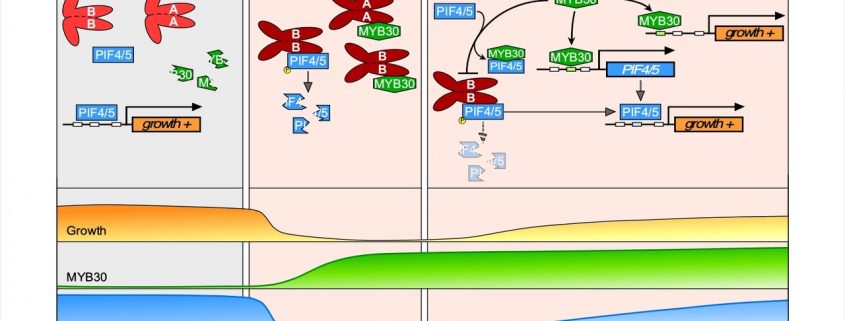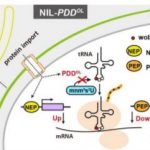MYB30 Promotes PIF4 and PIF5 Accumulation in the Light
Yan et al. discovered that MYB30, an R2R3-MYB family transcription factor, is a negative regulator of Arabidopsis photomorphogenic development and promotes PIF4 and PIF5 accumulation under prolonged red light irradiation. Plant Cell https://doi.org/10.1105/tpc.19.00645
By Yan Yan and Jigang Li, China Agricultural University)
Background: The red (600-700 nm) and far-red (700-750 nm) light components of sunlight are perceived by plants via phytochromes, which play fundamental roles in perception of the light environment and subsequent modulation of adaptative growth. PHYTOCHROME-INTERACTING FACTORS (PIFs), a subset of the basic helix-loop-helix (bHLH) family transcription factors, accumulate in dark-grown seedlings and repress seedling photomorphogenesis. Upon irradiation with red light, phytochromes are converted to the active Pfr form and translocate into the nucleus, where they interact with PIFs. The interaction of phytochromes with PIFs induces rapid phosphorylation and degradation of PIFs, thus relieving their repressive effects on photomorphogenesis. Phytochromes and PIFs together form a signaling module that plays an essential role in regulating plant responses to light.
Question: Are there other factors that regulate the phytochrome-PIF signaling module and photomorphogenesis?
Findings: We performed extensive yeast two-hybrid assays and discovered that MYB30, an R2R3-MYB family transcription factor, physically interacted with both phyA and phyB. The phenotypes of myb30 mutants in light conditions indicated that MYB30 is a key negative regulator of Arabidopsis photomorphogenic development. Interestingly, MYB30 protein levels are induced by phyA and phyB in the light, and MYB30 promotes PIF4 and PIF5 accumulation in the light both by directly binding to their promoters to induce their expression and by inhibiting the interaction of PIF4 and PIF5 with the active form of phyB. Therefore, upon exposure to red light, light-activated phytochromes induce rapid phosphorylation and degradation of PIFs. Simultaneously, they induce rapid accumulation of MYB30, which then promotes PIF4 and PIF5 reaccumulation under prolonged red-light irradiation. It seems likely that the role of MYB30 in phytochrome signaling could prevent an exaggerated response of plants to prolonged light exposure. In addition, our data indicate that MYB30 also interacts with PIFs and acts additively with them to promote hypocotyl growth in the light.
Next steps: We aim to elucidate the molecular mechanisms responsible for MYB30 degradation in the dark. In addition, we will also investigate the mechanism by which phytochromes induce MYB30 accumulation in the light.
Yan Yan, Cong Li, Xiaojing Dong, Hong Li, Dun Zhang, Yangyang Zhou, Bochen Jiang, Jing Peng, Xinyan Qin, Jinkui Cheng, Xiaoji Wang, Pengyu Song, Lijuan Qi, Yuan Zheng, Bosheng Li, William Terzaghi, Shuhua Yang, Yan Guo, and Jigang Li. (2020). MYB30 Is a Key Negative Regulator of Arabidopsis Photomorphogenic Development that Promotes PIF4 and PIF5 Protein Accumulation in the Light. Plant Cell. https://doi.org/10.1105/tpc.19.00645




